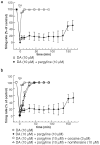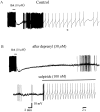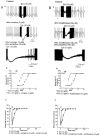Monoamine oxidase inhibition causes a long-term prolongation of the dopamine-induced responses in rat midbrain dopaminergic cells
- PMID: 9065488
- PMCID: PMC6573484
- DOI: 10.1523/JNEUROSCI.17-07-02267.1997
Monoamine oxidase inhibition causes a long-term prolongation of the dopamine-induced responses in rat midbrain dopaminergic cells
Abstract
The way monoamine oxidase (MAO) modulates the depression of the firing rate and the hyperpolarization of the membrane caused by dopamine (DA) on rat midbrain dopaminergic cells was investigated by means of intracellular recordings in vitro. The cellular responses to DA, attributable to the activation of somatodendritic D2/3 autoreceptors, were prolonged and did not completely wash out after pharmacological blockade of both types (A and B) of MAO. On the contrary, depression of the firing rate and membrane hyperpolarization induced by quinpirole (a direct D2 receptor agonist) were not affected by MAO inhibition. Furthermore, although the inhibition of DA reuptake by cocaine and nomifensine caused a short-term prolongation of DA responses, the combined inhibition of MAO A and B enzymes caused a long-term prolongation of DA effects. Moreover, the effects of DA were not largely prolonged during the simultaneous inhibition of MAO and the DA reuptake system. Interestingly, the actions of amphetamine were not clearly augmented by MAO inhibition. From the present data it is concluded that the termination of DA action in the brain is controlled mainly by MAO enzymes. This long-term prolongation of the dopaminergic responses suggests a substitutive therapeutic approach that uses MAO inhibitors and DA precursors in DA-deficient disorders in which continuous stimulation of the dopaminergic receptors is preferable.
Figures






Similar articles
-
Effect of long-term treatment with selective monoamine oxidase A and B inhibitors on dopamine release from rat striatum in vivo.J Neurochem. 1996 Oct;67(4):1532-9. doi: 10.1046/j.1471-4159.1996.67041532.x. J Neurochem. 1996. PMID: 8858937
-
Effects of selective monoamine oxidase inhibitors on the in vivo release and metabolism of dopamine in the rat striatum.J Neurochem. 1990 Sep;55(3):981-8. doi: 10.1111/j.1471-4159.1990.tb04587.x. J Neurochem. 1990. PMID: 2117053
-
Electrophysiological effects of monoamine oxidase inhibition on rat midbrain dopaminergic neurones: an in vitro study.Br J Pharmacol. 1996 Feb;117(3):528-532. doi: 10.1111/j.1476-5381.1996.tb15222.x. Br J Pharmacol. 1996. PMID: 8821544 Free PMC article.
-
Selective monoamine oxidase subtype inhibition and striatal extracellular dopamine in the guinea-pig.Br J Pharmacol. 2000 Aug;130(8):1992-8. doi: 10.1038/sj.bjp.0703493. Br J Pharmacol. 2000. PMID: 10952692 Free PMC article.
-
R-(-)-deprenyl (Selegiline, Movergan) facilitates the activity of the nigrostriatal dopaminergic neuron.J Neural Transm Suppl. 1987;25:45-66. J Neural Transm Suppl. 1987. PMID: 2828537 Review.
Cited by
-
Metabolic hormone action in the VTA: Reward-directed behavior and mechanistic insights.Physiol Behav. 2023 Sep 1;268:114236. doi: 10.1016/j.physbeh.2023.114236. Epub 2023 May 12. Physiol Behav. 2023. PMID: 37178855 Free PMC article. Review.
-
Obesity attenuates D2 autoreceptor-mediated inhibition of putative ventral tegmental area dopaminergic neurons.Physiol Rep. 2014 May 2;2(5):e12004. doi: 10.14814/phy2.12004. Print 2014. Physiol Rep. 2014. PMID: 24793981 Free PMC article.
-
Obesity decreases excitability of putative ventral tegmental area GABAergic neurons.Physiol Rep. 2013 Oct;1(5):e00126. doi: 10.1002/phy2.126. Epub 2013 Oct 23. Physiol Rep. 2013. PMID: 24303191 Free PMC article.
-
Reversal of dopamine-mediated firing inhibition through activation of the dopamine transporter in substantia nigra pars compacta neurons.Br J Pharmacol. 2018 Sep;175(17):3534-3547. doi: 10.1111/bph.14422. Epub 2018 Jul 23. Br J Pharmacol. 2018. PMID: 29933497 Free PMC article.
-
Dopamine neuronal loss contributes to memory and reward dysfunction in a model of Alzheimer's disease.Nat Commun. 2017 Apr 3;8:14727. doi: 10.1038/ncomms14727. Nat Commun. 2017. PMID: 28367951 Free PMC article.
References
-
- Butcher PS, Fairbrother IS, Kelly JS, Arbuthnott GW. Effects of selective monoamine oxidase inhibitors on the in vivo release and metabolism of dopamine in the rat striatum. J Neurochem. 1990;55:981–988. - PubMed
-
- Commissioning JW. Monoamine metabolites: their relationship to monoaminergic neuronal activity. Biochem Pharmacol. 1985;34:1127–1131. - PubMed
-
- Church WH, Justice IBJ, Byrd LD. Extracellular dopamine in rat striatum following uptake inhibition by cocaine, nomifensine and benztropine. Eur J Pharmacol. 1987;139:345–348. - PubMed
MeSH terms
Substances
LinkOut - more resources
Full Text Sources
